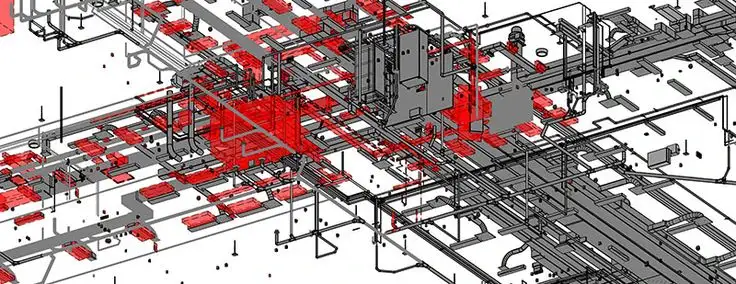In construction projects, MEP drawings are crucial for keeping everything in control. These drawings help everyone involved architects, engineers, and contractors—work collectively successfully. Knowing the different types of MEP drawings helps a wide audience understand their significance on a practical level.
In this guide, we’ll discover the 9 main types of MEP drawings and provide their components. These details will help you understand why each one is crucial for a successful construction.
What are MEP Drawings?

MEP stands for Mechanical, Electrical, and Plumbing. MEP drawings are special drawings that show how Mechanical, Electrical, and Plumbing structures are involved in construction. These drawings are like blueprints for the systems that keep the building systems running smoothly. They include things such as heating and cooling systems (mechanical), wiring and electrical panels (electrical), and pipes for water and sewage (plumbing).
MEP drawings help everybody involved in the construction system. They are essential because they ensure that each different structure works well together. They make the building secure and comfortable for everyone who uses it.
9 Types of MEP Drawings
1. HVAC Layout Drawings
HVAC layout drawings display how the heating, ventilation, and air conditioning systems could be mounted in a building. These drawings are critical for keeping the indoor surroundings comfortable.
They include information about all of the elements of the HVAC system. In this way, you’ll see where the ducts will go, how the vents are placed, and where the HVAC units are located. Ducts are like big tubes that transfer air throughout the building. Vents are openings where the air comes out or goes in. HVAC units are the machines that heat or cool the air.
By displaying precisely where each of these components is going, HVAC layout drawings make sure that the system works effectively and make everyone comfortable in the building.
2. Electrical Power Layout Drawings
Electrical power layout drawings are all about planning how power would be distributed in a building. The drawings consist of details on electrical panels. They are like control centers for managing electricity. These drawings also show the wiring, the roadways that bring electricity to different areas of the building. Outlets are in which you plug your gadgets and appliances.
These drawings are important because they ensure that electricity is distributed efficiently. In this manner, all areas of the building get the proper amount of energy. Without a clear electrical power layout, you may run into troubles like overloaded circuits or power outages, which may be both inconvenient and dangerous.
3. Lighting Layout Drawings
Lighting layout drawings are like a map for lights, helping to plan how every space will be lit. They show where each light fixture will go, including ceiling lighting, wall sconces, and lamps. They also display where the switches might be positioned so you can effortlessly turn lighting fixtures on and off. Plus, they include emergency lighting fixtures places, which are critical for safety in case of a power outage.
Good lighting layout drawings are essential for both energy efficiency and protection. They help make certain that electricity is used nicely, reducing waste and lowering power bills.
4. Plumbing Layout Drawings
Plumbing layout drawings are like a guide for putting in the plumbing system. They show details of where all the pipes will move, how the valves are positioned, and how water supply lines are related. They also display the structure of the drainage system, that transfers waste water away from the building.
A good plumbing system is vital because it ensures that clean water is going to the faucets and that waste water is well eliminated.
5. Fire Protection Layout Drawings
Fire protection layout drawings display how fire safety systems will be set up in a building. They consist of information on where fire sprinklers will be installed. Fire sprinklers spray water where the sensor senses fire in the building. These drawings also display where fire alarm structures can be located. These alarms alert humans to evacuate the building if there’s a fire.
Additionally, the layout consists of the places of fire extinguishers, that are used to put out small fires. A good fire protection system is important to make the building safe and secure for everyone.
6. Gas Supply Layout Drawings
Gas supply layout drawings display how gas pipelines and connections are installed in a building. They give information on the paths of gas pipelines, showing where the pipes will run through the building. They also show how these pipes connect with appliances like stoves, heaters, and water warmers.
Gas supply drawings are very essential for protection and efficient energy use. They ensure that gas is supplied appropriately and successfully to where it’s needed.
7. MEP Shop Drawings
MEP shop drawings are certain plans that show how Mechanical, Electrical, and Plumbing structures will be installed in a building. Unlike the basic MEP drawings that outline the system layout, shop drawings provide more detailed information on how the systems will be constructed and put together.
These drawings include specific measurements and installation details for things like HVAC units, electric wiring, and plumbing pipes. They help prevent mistakes and ensure that the systems are installed properly. These drawings can save time and reduce costs. This allows contractors and developers to understand exactly what needs to be done during installation.
8. Communication Systems Drawings
Communication system drawings include details on where telephone lines will be installed, how internet cables will be run, and where security cameras and alarms will be placed. This helps ensure that all the tech systems work together smoothly.
A good telecommunication system means that you have a good internet and phone connection. This system ensures a good communication path throughout the building.
9. Schematic Diagrams
Schematic diagrams provide a simplified view of complex systems, making them easier to understand. Instead of showing every detail, these diagrams use symbols and lines to represent how different parts of a system are connected and work together.
For example, in a schematic diagram of an electrical system, you’ll see simple symbols for switches, wires, and devices, and lines showing how they are connected. This helps to get a clear picture of how everything fits together without getting lost in technical details.
Conclusion
MEP drawings are essential for making construction projects run smoothly. Each type of MEP drawing whether it’s for HVAC systems, electrical layouts, lighting, plumbing, fire protection, gas supply, or communication systems plays a crucial role in ensuring that everything in a building works well together.
Understanding these drawings helps architects, engineers, and contractors to plan, install, and maintain each system properly. This efficient planning keeps the building safe and comfortable for everyone.
FAQs
Q1. What is the meaning of MEP drawings?
MEP drawings show the design and layout of Mechanical, Electrical, and Plumbing systems in a building. They help ensure that these systems work well together and keep the building functional and comfortable.
Q2. What are MEP shop drawings?
MEP shop drawings provide detailed plans for how Mechanical, Electrical, and Plumbing systems will be installed. They include specific measurements and installation instructions to guide contractors and prevent mistakes.
Q3. Which MEP drawing is vital for efficient HVAC systems?
HVAC layout drawings are vital for efficient HVAC systems. They show where components like ducts, vents, and HVAC units will be placed, helping to ensure the system works effectively and keeps the building comfortable.
